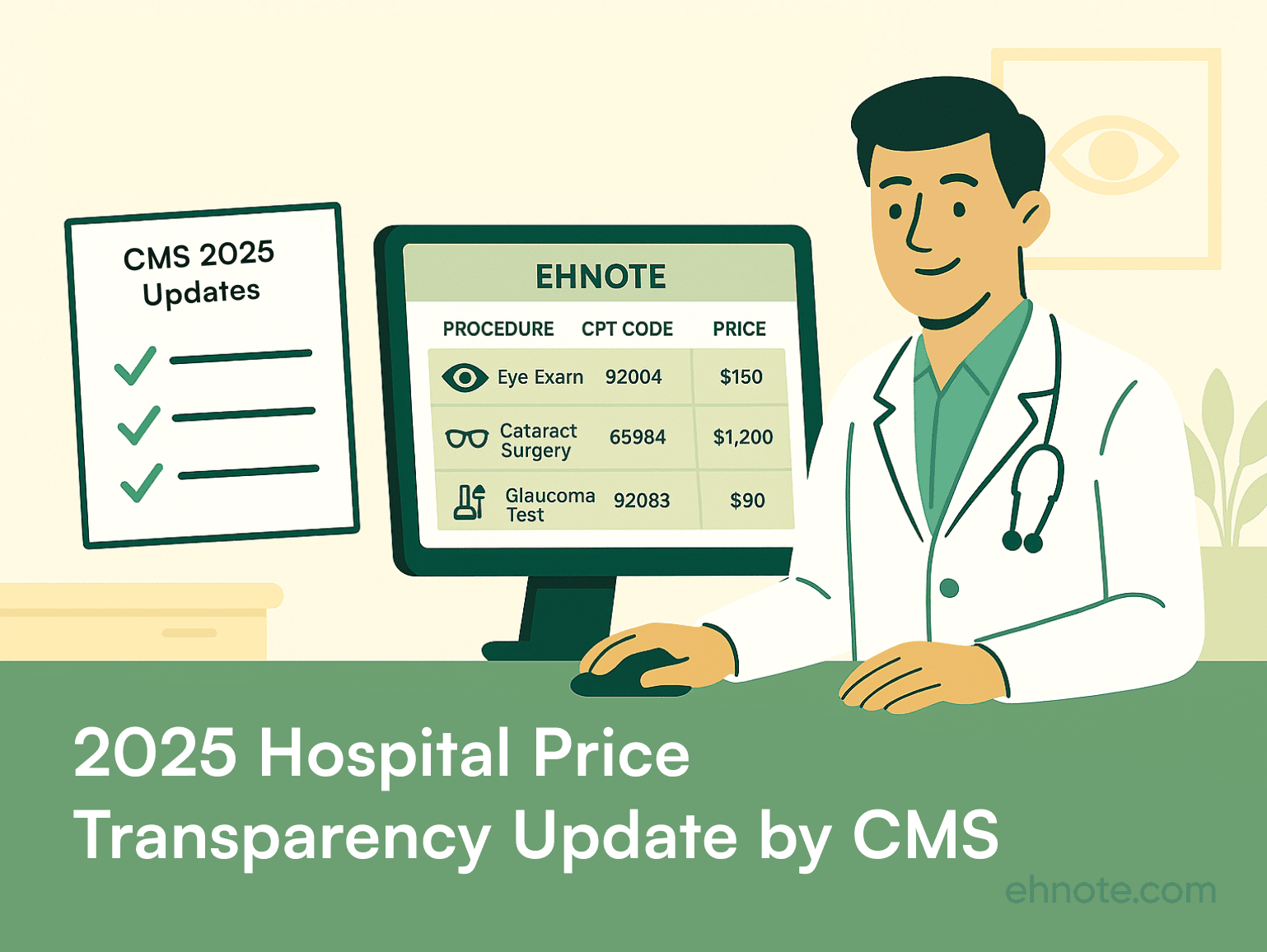2025 Hospital Price Transparency Update by CMS: How EHNOTE Simplifies Compliance for Ophthalmology Practices
On May 22, 2025, the Centers for Medicare & Medicaid Services (CMS) released updated guidance on Hospital Price Transparency (HPT), implementing the President’s Executive Order to make healthcare pricing clearer and more actionable for patients.
This guidance, effective immediately, requires hospitals to provide actual dollar amounts for services in a standardized, machine-readable format—moving away from estimates or placeholders.
For ophthalmology practices, this shift is more than a regulatory checkbox; it’s an opportunity to enhance patient trust, streamline operations, and ensure compliance without added stress.
But let’s be honest: navigating these changes can feel daunting. That’s where EHNOTE steps in. As a leading ophthalmology-specific EHR, EHNOTE is designed to make compliance seamless, so you can focus on what matters most—delivering exceptional eye care.
The CMS Guidance: What’s New and Why It Matters for Ophthalmology
The updated HPT guidance emphasizes two key changes:
- Actual Dollar Amounts: Hospitals must now encode standard charge dollar amounts in their machine-readable files (MRFs) for all services, including payer-specific negotiated charges. This replaces the previous practice of using placeholders like "999999999" when exact amounts were unavailable.
- Standardized Data Encoding: CMS requires hospitals to calculate and display an "estimated allowed amount" based on historical data, ensuring pricing information is meaningful and comparable across providers.
For ophthalmology practices, this means providing clear, accurate pricing for a wide range of services—from routine eye exams to complex procedures like cataract surgery or retinal detachment repair. The stakes are high: non-compliance can lead to fines, audits, and reputational damage. But more importantly, transparent pricing builds patient trust, a cornerstone of successful eye care practices in today’s healthcare landscape.
You might be thinking, "How do I ensure my practice meets these requirements without drowning in administrative tasks?" That’s where EHNOTE comes in. Let’s explore how it can help you stay compliant while enhancing your practice’s efficiency.
Why Compliance Is Complex for Ophthalmology
Ophthalmology is unique. Your practice handles everything from high-volume diagnostic tests to intricate surgeries, each with its own pricing structure. Consider the diversity of your services:
- Diagnostic Imaging: OCT scans, visual field tests, and fundus photos, each with varying costs based on payer agreements.
- Surgical Procedures: Cataract surgeries, LASIK, and corneal transplants, where pricing can fluctuate based on equipment, staff, and facility fees.
- Routine Care: Eye exams and glaucoma screenings, often subject to different reimbursement rates.
Encoding these services into a standardized, machine-readable format—while ensuring the data is accurate and up-to-date—can feel like a full-time job. A 2023 Ophthalmology Management report found that 68% of surgical teams face rework due to data silos, costing 2-3 hours weekly per provider. With the new CMS guidance, the risk of non-compliance adds another layer of complexity.
But here’s the good news: EHNOTE is built to handle this. Our built-in ophthalmic counseling module is designed to integrate pricing data seamlessly, ensuring your practice meets CMS requirements without disrupting your workflow.
How EHNOTE Simplifies HPT Compliance for Your Practice
EHNOTE’s ophthalmology-specific EHR is more than a clinical tool—it’s a compliance partner. Here’s how it helps you navigate the new HPT guidance:
1. Automated Pricing Calculations for Accuracy
You’re busy enough without manually calculating pricing for every service. EHNOTE’s built-in counselor module centralizes your practice’s pricing structure for consultations, surgeries, diagnoses, and treatments across all locations. When a treatment plan is selected—say, a cataract surgery or glaucoma screening—the pricing details are automatically applied, with the total collection reflected in billing by summing all costs. Managed centrally, these prices update automatically on your front-line staff’s screens, ensuring MRFs are compliant with CMS’s requirement for actual dollar amounts. This reduces errors and saves your team valuable time.
2. Seamless Integration with Existing Workflows
Compliance shouldn’t mean overhauling your entire system. EHNOTE integrates directly with your practice’s workflows, from scheduling to billing. For example, when you schedule a cataract surgery, the counselor module links the procedure to its centralized pricing data, ensuring it’s encoded in the MRF. This seamless integration means you’re always ready for an audit, without extra steps.
3. Built-In Compliance and Tracking for Audit Readiness
EHNOTE’s built-in compliance and tracking features ensure your practice is audit-ready, providing a clear audit trail for pricing decisions. Unlike relying on a single view, this system logs all pricing changes and updates, meeting CMS’s demand for transparent, accurate data. This not only satisfies regulatory requirements but also reinforces patient trust by offering a verifiable record of costs.
4. Real-Time Updates for Dynamic Pricing
Payer contracts change, and so do your prices. EHNOTE’s real-time update feature ensures that any adjustments to your centralized pricing—whether due to a new contract or updated fee schedule—are reflected instantly in your MRFs. This keeps your practice compliant and avoids the headaches of manual updates.
5. User-Centric Design for Easy Compliance
We know compliance can feel overwhelming, especially with the new CMS requirements. That’s why EHNOTE’s user-centric design simplifies the process. Our intuitive interface guides you through encoding pricing data, with built-in checks to ensure you’re meeting CMS standards. Plus, our support team is always available to help you navigate any compliance questions.
Practical Example: Simplifying Pricing for Cataract Surgery
Let’s walk through a real-world scenario. You’re preparing to provide a patient with a cost estimate for cataract surgery. Under the new HPT guidance, you need to provide an actual dollar amount for the procedure, based on their specific payer contract.
With EHNOTE, it’s simple:
- Access the 360-Degree Patient Data View: Open the unified patient profile to verify their insurance validity, coverage details, and payer information.
- Generate the Pricing Data: EHNOTE’s patient eligibility verification and digital claim processing tools assess the patient’s insurance, determining coverage and processing the claim to reflect the appropriate pricing within the centralized structure, ensuring compliance with CMS requirements.
- Share with the Patient: Provide the patient with a clear, compliant cost estimate, building trust, and ensuring they understand their financial responsibility.
This process not only meets CMS requirements but also enhances the patient experience—something generic EHRs struggle to achieve.
Compliance Made Easy
We know you’re worried about the time and complexity of compliance. Here’s how EHNOTE addresses those concerns:
- Time-Saving Automation: No more manual calculations or data entry. EHNOTE automates pricing encoding, freeing your team to focus on patient care.
- Compliance tracking: EHNOTE’s system comes with built-in compliance tracking, ensuring you’re always audit-ready.
- Training and Support: Our team provides hands-on training to ensure your staff can navigate the new requirements with confidence.
You’re not just getting an EHR—you’re getting a partner committed to your practice’s success.

.png)


Comments
Post a Comment